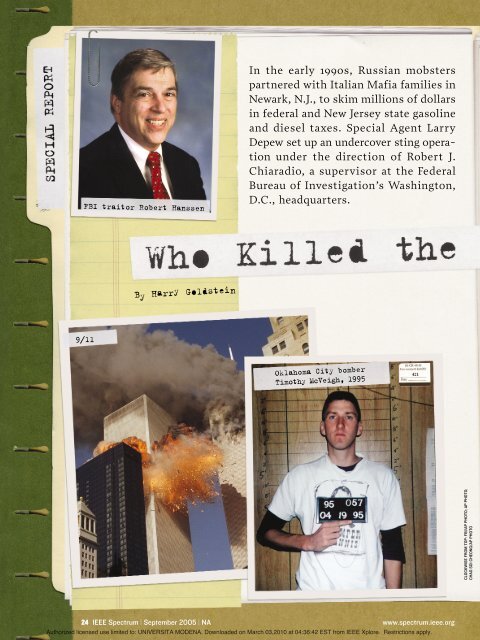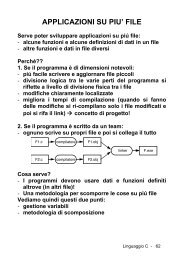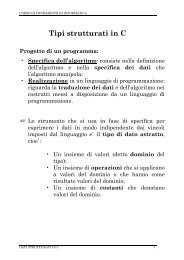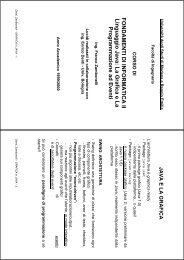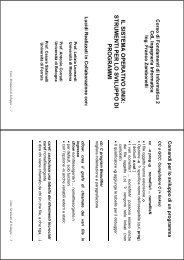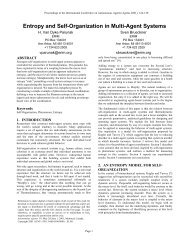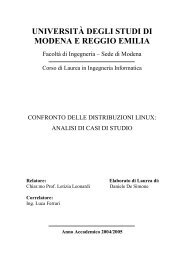Who Killed the Virtual Case File
Who Killed the Virtual Case File
Who Killed the Virtual Case File
- No tags were found...
You also want an ePaper? Increase the reach of your titles
YUMPU automatically turns print PDFs into web optimized ePapers that Google loves.
FBI traitor Robert Hanssen<br />
In <strong>the</strong> early 1990s, Russian mobsters<br />
partnered with Italian Mafia families in<br />
Newark, N.J., to skim millions of dollars<br />
in federal and New Jersey state gasoline<br />
and diesel taxes. Special Agent Larry<br />
Depew set up an undercover sting operation<br />
under <strong>the</strong> direction of Robert J.<br />
Chiaradio, a supervisor at <strong>the</strong> Federal<br />
Bureau of Investigation’s Washington,<br />
D.C., headquarters.<br />
By Harry Goldstein<br />
9/11<br />
Oklahoma City bomber<br />
Timothy McVeigh, 1995<br />
CLOCKWISE FROM TOP: FBI/AP PHOTO; AP PHOTO;<br />
CHAO SOI CHEONG/AP PHOTO<br />
24 IEEE Spectrum | September 2005 | NA www.spectrum.ieee.org<br />
Authorized licensed use limited to: UNIVERSITA MODENA. Downloaded on March 03,2010 at 04:36:42 EST from IEEE Xplore. Restrictions apply.
Anthrax attack, 2001<br />
D.C. sniper<br />
John Allen Muhammad, 2002<br />
How <strong>the</strong> FBI blew more than<br />
$100 million on case-management<br />
software it will never use<br />
FROM LEFT: STEVE HELBER/AP PHOTO;<br />
KENNETH LAMBERT/AP PHOTO<br />
Depew collected reams of evidence from wiretaps,<br />
interviews, and financial transactions over <strong>the</strong> course of<br />
two and a half years. Unfortunately, <strong>the</strong> FBI couldn’t provide<br />
him with a database program that would help organize<br />
<strong>the</strong> information, so Depew wrote one himself. He used<br />
it to trace relationships between telephone calls, meetings,<br />
surveillance, and interviews, but he could not import<br />
information from o<strong>the</strong>r investigations that might shed<br />
light on his own. So it wasn’t until Depew mentioned <strong>the</strong><br />
name of a suspect to a colleague that he obtained a briefcase<br />
that his friend had been holding since 1989.<br />
“When I opened it up, it was a treasure trove of information<br />
about who’s involved in <strong>the</strong> conspiracy, including<br />
<strong>the</strong> Gambino family, <strong>the</strong> Genovese family, and <strong>the</strong><br />
Russian components. It listed percentages of who got<br />
what, when people were supposed to pay, <strong>the</strong> number of<br />
gallons. It became a central piece of evidence,” Depew<br />
recalled during an interview at <strong>the</strong> FBI’s New Jersey<br />
Regional Computer Forensic Laboratory, in Hamilton,<br />
where he is <strong>the</strong> director. “Had I not just picked up <strong>the</strong><br />
phone and called that agent, I never would have gotten it.”<br />
A decade later, Depew’s need to share information combined<br />
with his do-it-yourself database skills and connection<br />
to his old supervisor, Chiaradio, would land him a job<br />
managing his first IT project—<strong>the</strong> FBI’s <strong>Virtual</strong> <strong>Case</strong> <strong>File</strong>.<br />
Depew’s appointment to <strong>the</strong> FBI’s VCF team was an<br />
auspicious start to what would become <strong>the</strong> most highly<br />
publicized software failure in history. The VCF was supposed<br />
to automate <strong>the</strong> FBI’s paper-based work environment,<br />
allow agents and intelligence analysts to share vital<br />
investigative information, and replace <strong>the</strong> obsolete<br />
Automated <strong>Case</strong> Support (ACS) system. Instead, <strong>the</strong> FBI<br />
claims, <strong>the</strong> VCF’s contractor, Science Applications<br />
International Corp. (SAIC), in San Diego, delivered<br />
700 000 lines of code so bug-ridden and functionally off<br />
target that this past April, <strong>the</strong> bureau had to scrap <strong>the</strong><br />
US $170 million project, including $105 million worth of<br />
unusable code. However, various government and independent<br />
reports show that <strong>the</strong> FBI—lacking IT management<br />
and technical expertise—shares <strong>the</strong> blame for <strong>the</strong><br />
project’s failure.<br />
In a devastating 81-page audit, released in 2005, Glenn<br />
A. Fine, <strong>the</strong> U.S. Department of Justice’s inspector general,<br />
described eight factors that contributed to <strong>the</strong> VCF’s<br />
www.spectrum.ieee.org September 2005 | IEEE Spectrum | NA 25<br />
Authorized licensed use limited to: UNIVERSITA MODENA. Downloaded on March 03,2010 at 04:36:42 EST from IEEE Xplore. Restrictions apply.
COUNTDOWN TO<br />
CATASTROPHE<br />
****************<br />
*SEPTEMBER 2000<br />
FBI IT Upgrade<br />
Project, later<br />
called Trilogy,<br />
funded for<br />
US $379.8 million.<br />
*SEPTEMBER 2001<br />
Robert S. Mueller<br />
III replaces Louis<br />
J. Freeh as FBI<br />
director a week<br />
before <strong>the</strong> terrorist<br />
attacks of 9/11.<br />
*OCTOBER 2001<br />
Robert J. Chiaradio<br />
[below] advises<br />
Mueller on software<br />
he dubs <strong>the</strong><br />
<strong>Virtual</strong> <strong>Case</strong> <strong>File</strong><br />
and brings Larry<br />
Depew aboard.<br />
*JANUARY 2002<br />
FBI receives<br />
an additional<br />
$78 million to<br />
accelerate Trilogy.<br />
*FEBRUARY 2002<br />
Joint Application<br />
Development<br />
planning sessions<br />
begin; Sherry<br />
Higgins hired.<br />
*AUGUST 2002<br />
Mat<strong>the</strong>w Patton<br />
hired by SAIC as<br />
security engineer.<br />
failure. Among <strong>the</strong>m: poorly defined and slowly<br />
evolving design requirements; overly ambitious<br />
schedules; and <strong>the</strong> lack of a plan to guide hardware<br />
purchases, network deployments, and software<br />
development for <strong>the</strong> bureau.<br />
Fine concluded that four years after terrorists<br />
crashed jetliners into <strong>the</strong> World Trade Center and<br />
<strong>the</strong> Pentagon, <strong>the</strong> FBI, which had been criticized<br />
for not “connecting <strong>the</strong> dots” in time to prevent<br />
<strong>the</strong> attacks, still did not have <strong>the</strong> software necessary<br />
to connect any new dots that might come<br />
along. And won’t for years to come.<br />
“The archaic Automated <strong>Case</strong> Support system—which<br />
some agents have avoided using—<br />
is cumbersome, inefficient, and limited in its capabilities,<br />
and does not manage, link, research,<br />
analyze, and share information as effectively or<br />
timely as needed,” Fine wrote. “[T]he continued<br />
delays in developing <strong>the</strong> VCF affect <strong>the</strong> FBI’s<br />
ability to carry out its critical missions.”<br />
This past May, a month after it officially ended<br />
<strong>the</strong> VCF project, <strong>the</strong> FBI announced that it would<br />
buy off-<strong>the</strong>-shelf software at an undisclosed cost<br />
to be deployed in phases over <strong>the</strong> next four years.<br />
Until those systems are up and running, however,<br />
<strong>the</strong> FBI will rely on essentially <strong>the</strong> same combination<br />
of paper records and antiquated software<br />
that <strong>the</strong> failed VCF project was supposed to<br />
replace. The only recent addition has been a new<br />
“investigative data warehouse” that combines several<br />
of <strong>the</strong> FBI’s crime and evidence databases into<br />
one. It was completed as <strong>the</strong> VCF started its final<br />
slide into oblivion. In addition, <strong>the</strong> FBI recently<br />
digitized millions of its paper documents and<br />
made <strong>the</strong>m available to agents.<br />
As <strong>the</strong> FBI gears up to spend hundreds of millions<br />
more on software over <strong>the</strong> next several years,<br />
questions persist as to how exactly <strong>the</strong> VCF went<br />
so terribly wrong and whe<strong>the</strong>r a debacle of even<br />
bigger proportions looms on <strong>the</strong> horizon. Despite<br />
high-profile Congressional hearings, hundreds of<br />
pages of reports churned out by oversight bodies,<br />
and countless anguished articles in <strong>the</strong> trade<br />
press and mainstream media, <strong>the</strong> inner workings<br />
of <strong>the</strong> project and <strong>the</strong> major players have remained<br />
largely invisible. Now, detailed interviews with<br />
people directly involved with <strong>the</strong> VCF paint a picture<br />
of an enterprise IT project that fell into<br />
<strong>the</strong> most basic traps of software development,<br />
from poor planning to bad communication.<br />
Lost amid <strong>the</strong> recriminations was an early warning<br />
from one member of <strong>the</strong> development team that<br />
questioned <strong>the</strong> FBI’s technical expertise, SAIC’s<br />
management practices, and <strong>the</strong> competence of both<br />
organizations. Mat<strong>the</strong>w Patton, a security expert<br />
working for SAIC, aired his objections to his supervisor<br />
in <strong>the</strong> fall of 2002. He <strong>the</strong>n posted his concerns<br />
to a Web discussion board just before SAIC<br />
and <strong>the</strong> FBI agreed on a deeply flawed 800-page set<br />
of system requirements that doomed <strong>the</strong> project<br />
before a line of code was written. His reward: a visit<br />
from two FBI agents concerned that he had disclosed<br />
national security secrets on <strong>the</strong> Internet.<br />
TO UNDERSTAND WHY THE VCF was so<br />
important, you’ve got to understand <strong>the</strong> FBI. And<br />
to understand <strong>the</strong> FBI, you’ve got to understand<br />
its organization and its agents. The bureau, headquartered<br />
in <strong>the</strong> J. Edgar Hoover Building in Washington,<br />
D. C., currently has 23 divisions, including<br />
counterintelligence, criminal investigation, and<br />
cybercrime. The divisions fall under <strong>the</strong> control of<br />
five executive assistant directors responsible<br />
for intelligence, counterterrorism and counterintelligence,<br />
criminal investigations, law enforcement<br />
services (such as labs and training), and<br />
administration. Until last year, each division had its<br />
own IT budget and systems. And because divisions<br />
had <strong>the</strong> freedom and money to develop <strong>the</strong>ir own<br />
software, <strong>the</strong> FBI now has 40 to 50 different investigative<br />
databases and applications, many duplicating<br />
<strong>the</strong> functions and information found in o<strong>the</strong>rs.<br />
Last year, in an effort to centralize IT operations and<br />
eliminate needless redundancies, <strong>the</strong> FBI’s chief<br />
information officer, who reports to <strong>the</strong> director, took<br />
charge of all its IT budgets and systems.<br />
The bureau’s 12 400 agents work out of 56 field<br />
offices and 400 satellite—or resident agency—<br />
offices, as well as 51 Legal Attaché offices scattered<br />
across <strong>the</strong> globe in U.S. embassies and consulates.<br />
A field agent works as part of a squad; each squad<br />
has a supervisor, who reports to <strong>the</strong> assistant<br />
special agent in charge, who in turn reports to <strong>the</strong><br />
special agent in charge of <strong>the</strong> field office. Agents<br />
investigate everything from counterterrorism leads<br />
to bankruptcy fraud, online child pornography<br />
rings to corrupt public officials, art <strong>the</strong>fts to kidnappings.<br />
They interview witnesses, develop<br />
informants, conduct surveillance, hunt for clues,<br />
and collaborate with local law enforcement to find<br />
and arrest criminals. Agents document every step<br />
and methodically build case files. They spend a<br />
tremendous amount of time processing paperwork,<br />
faxing and FedEx-ing standardized memo and requisition<br />
forms through <strong>the</strong> approval chain—up to<br />
<strong>the</strong> squad supervisor and eventually to <strong>the</strong> special<br />
agent in charge. This system of forms and<br />
approvals stretches back to <strong>the</strong> 1920s, when J. Edgar<br />
Hoover, director from 1924 to 1972, standardized<br />
all of <strong>the</strong> bureau’s investigative reports on forms,<br />
so an agent could walk into any FBI office and find<br />
<strong>the</strong> same system.<br />
Today, <strong>the</strong> bureau has hundreds of standard<br />
forms. To record contact with an informant, fill<br />
out Form FD-209. When getting married or divorced,<br />
complete Form FD-292. To report information<br />
gleaned from an interview that may later<br />
become testimony, use Form FD-302. To conduct<br />
a wiretap, file Form FD-472. To wire an informant<br />
with a body recorder and transmitter, submit<br />
Form FD-473. After traveling overseas for business<br />
or pleasure, report <strong>the</strong> experience on Form FD-772.<br />
Plan an arrest with Form FD-888. Open a drug<br />
investigation with Form FD-920.<br />
Forms related to investigations, such as those<br />
used to report interviews with witnesses, wend <strong>the</strong>ir<br />
way up and down <strong>the</strong> approval chain. Once <strong>the</strong><br />
COMPUTERWORLD<br />
26 IEEE Spectrum | September 2005 | NA www.spectrum.ieee.org<br />
Authorized licensed use limited to: UNIVERSITA MODENA. Downloaded on March 03,2010 at 04:36:42 EST from IEEE Xplore. Restrictions apply.
CHAD DOWLING<br />
appropriate supervisors sign off on <strong>the</strong> form, it goes<br />
back to <strong>the</strong> agent, who gives it to a clerk to enter<br />
into <strong>the</strong> ACS system. From <strong>the</strong>re, <strong>the</strong> paper form<br />
is filed as part of <strong>the</strong> official record of <strong>the</strong> case.<br />
Sometimes, though <strong>the</strong> FBI officially denies<br />
this, an agent doesn’t enter all case notes into<br />
ACS. Some agents think, “If I don’t trust ACS<br />
because I don’t think it will protect my informant<br />
or my asset, I’m not putting <strong>the</strong> data in <strong>the</strong>re,”<br />
said Depew, an avid user of ACS who touted <strong>the</strong><br />
electronic system to his fellow agents as safer than<br />
a paper filing system.<br />
FBI spokesperson Megan Baroska emphasized<br />
in an e-mail that Depew did not speak for <strong>the</strong><br />
bureau in this instance. “The FBI policy is for all<br />
official records to be entered into ACS. Additionally,<br />
‘notes’ per say [sic] are not entered into<br />
ACS; <strong>the</strong>y are first memorialized in a 302 form,<br />
and that form is entered into ACS. As for <strong>the</strong><br />
‘notes,’ <strong>the</strong>y are kept in storage as a paper file<br />
because <strong>the</strong>y legally have to be discoverable.”<br />
When asked during an interview at FBI headquarters<br />
if agents felt uncomfortable about exchanging<br />
a paper-based system for an electronic<br />
one, <strong>the</strong> FBI’s current CIO, Zalmai Azmi, didn’t<br />
think agents would find it hard to get into <strong>the</strong><br />
habit of processing forms electronically. But introducing<br />
an electronic record-keeping system does<br />
raise legal policy questions in <strong>the</strong>ir minds. “What<br />
is a record and what is available under discovery<br />
In a paper world, you do your job, you do your<br />
notes, and if you don’t like it, it goes somewhere,”<br />
Azmi said. “In an electronic world, nothing really is destroyed;<br />
it’s always somewhere.”<br />
DESPITE AGENTS' RELUCTANCE to embrace <strong>the</strong> digital<br />
age, in 2000 <strong>the</strong> bureau finally began to deal with its outdated<br />
IT systems. At <strong>the</strong> time, under <strong>the</strong> direction of Louis J. Freeh,<br />
<strong>the</strong> bureau had nei<strong>the</strong>r a CIO nor documentation detailing its IT<br />
systems, much less a plan for revamping <strong>the</strong>m. The task of creating<br />
such a plan fell to former IBM executive Bob E. Dies, who<br />
became assistant director in charge of <strong>the</strong> FBI Information<br />
Resources Division on 17 July 2000. He was <strong>the</strong> first of five officials<br />
who, over <strong>the</strong> next four years, would struggle to lead <strong>the</strong> FBI’s<br />
sprawling and antiquated information systems and get <strong>the</strong> VCF<br />
project under way.<br />
According to a 2002 report from <strong>the</strong> DOJ’s Office of <strong>the</strong> Inspector<br />
General, when Dies arrived, 13 000 computers could not run modern<br />
software. Most of <strong>the</strong> 400 resident agency offices were connected<br />
to <strong>the</strong> FBI intranet with links about <strong>the</strong> speed of a 56-kilobit-persecond<br />
modem. Many of <strong>the</strong> bureau’s network components were no<br />
longer manufactured or supported. And agents couldn’t e-mail U.S.<br />
Attorney offices, federal agencies, local law enforcement, or each<br />
o<strong>the</strong>r; instead, <strong>the</strong>y typically faxed case-related information.<br />
In September 2000, Congress approved $379.8 million over<br />
three years for what was <strong>the</strong>n called <strong>the</strong> FBI Information Technology<br />
Upgrade Project. Eventually divided into three parts,<br />
<strong>the</strong> program became known as Trilogy. The Information Presentation<br />
Component would provide all 56 FBI field offices, some<br />
22 000 agents and support staff, with new Dell Pentium PCs running<br />
Microsoft Office, as well as new scanners, printers, and<br />
servers. The Transportation Network Component would provide<br />
secure local area and wide area networks, allowing agents to<br />
RICK REYNOLDS of Science Applications International Corp. took over <strong>the</strong><br />
<strong>Virtual</strong> <strong>Case</strong> <strong>File</strong> project in 2004 and saw it through to <strong>the</strong> bitter end.<br />
share information with <strong>the</strong>ir supervisors and each o<strong>the</strong>r.<br />
But <strong>the</strong> User Applications Component, which would ultimately<br />
become <strong>the</strong> VCF, staked out <strong>the</strong> most ambitious goals. First, it was<br />
to make <strong>the</strong> five most heavily used investigative applications—<br />
<strong>the</strong> Automated <strong>Case</strong> Support system, IntelPlus, <strong>the</strong> Criminal Law<br />
Enforcement Application, <strong>the</strong> Integrated Intelligence Information<br />
Application, and <strong>the</strong> Telephone Application—accessible via a pointand-click<br />
Web interface. Next, it would rebuild <strong>the</strong> FBI’s intranet.<br />
Finally, it was supposed to identify a way to replace <strong>the</strong> FBI’s 40-odd<br />
investigative software applications, including ACS.<br />
Based on <strong>the</strong> 1970s-era database Adabas and written in a programming<br />
language called Natural, both from Software AG,<br />
Darmstadt, Germany, <strong>the</strong> Automated <strong>Case</strong> Support system, which<br />
debuted in 1995, was antiquated even as it was deployed—and it is<br />
still being used today. Originally, agents and clerks accessed <strong>the</strong> program<br />
via vintage IBM 3270 green-screen terminals connected to a<br />
mainframe over dedicated lines. Eventually, <strong>the</strong> 3270 terminals were<br />
emulated on standard desktop PCs. By navigating complicated menus<br />
using function keys and keystroke commands, agents could do basic<br />
Boolean and keyword searches for things like an informant’s name<br />
or <strong>the</strong> dates of a wiretap surveillance, information related to cases<br />
<strong>the</strong>y were working. But according to Depew, only <strong>the</strong> most dedicated,<br />
computer-savvy agents had <strong>the</strong> skills and patience to learn<br />
<strong>the</strong> arcane system, let alone exploit it to its full potential.<br />
“Nobody really understood why we would even use ACS o<strong>the</strong>r<br />
than as an index,” said Depew. A notable exception: Robert<br />
Hanssen, <strong>the</strong> notorious FBI traitor, used <strong>the</strong> system to find documents<br />
his Russian handlers might find useful, as well as to check<br />
to see if anyone at <strong>the</strong> FBI was onto him [see “Mission Impossible,”<br />
IEEE Spectrum, April 2003].<br />
In May and June 2001, <strong>the</strong> bureau awarded Trilogy contracts to<br />
www.spectrum.ieee.org September 2005 | IEEE Spectrum | NA 27<br />
Authorized licensed use limited to: UNIVERSITA MODENA. Downloaded on March 03,2010 at 04:36:42 EST from IEEE Xplore. Restrictions apply.
*NOVEMBER 2002<br />
SAIC and FBI<br />
agree on baseline<br />
requirements; Patton<br />
[above] leaves SAIC.<br />
*DECEMBER 2002<br />
FBI receives ano<strong>the</strong>r<br />
$123.2 million to<br />
complete Trilogy.<br />
*SEPTEMBER 2003<br />
GAO reports that FBI<br />
needs an enterprise<br />
architecture.<br />
*DECEMBER 2003<br />
Zalmai Azmi becomes<br />
acting CIO; SAIC<br />
delivers VCF.<br />
*MARCH 2004<br />
Arbitrator finds<br />
that of 59 problems,<br />
19 were FBI changes<br />
to requirements and<br />
40 were SAIC errors.<br />
*JUNE 2004<br />
FBI asks SAIC to<br />
develop Initial Operating<br />
Capability (IOC)<br />
for $16.4 million;<br />
FBI contracts<br />
Aerospace Corp. to<br />
evaluate <strong>the</strong> VCF.<br />
*JANUARY 2005<br />
Field trials of IOC<br />
begin; Aerospace Corp.<br />
delivers its report.<br />
*FEBRUARY 2005<br />
Final Office of <strong>the</strong><br />
Inspector General’s<br />
report on Trilogy<br />
comes out; Senate<br />
hearing, 3 February.<br />
*APRIL 2005<br />
FBI officially kills<br />
<strong>the</strong> <strong>Virtual</strong> <strong>Case</strong> <strong>File</strong>.<br />
*MAY 2005<br />
Mueller announces a<br />
new software project<br />
called Sentinel.<br />
*DECEMBER 2005<br />
Contract for phase<br />
one of Sentinel to<br />
be awarded.<br />
two major U.S. government contractors: DynCorp,<br />
of Reston, Va., for <strong>the</strong> hardware and network projects,<br />
and to SAIC for software. All three Trilogy<br />
components were to be delivered by <strong>the</strong> middle of<br />
2004. Instead of paying a fixed price for <strong>the</strong> hardware,<br />
networks, and software, <strong>the</strong> FBI used costplus-award<br />
fee contracts. These would pay <strong>the</strong> cost<br />
of all labor and materials plus additional money<br />
if <strong>the</strong> contractor managed costs commendably.<br />
Crucially, if <strong>the</strong> scope of <strong>the</strong> project expanded or if<br />
<strong>the</strong> contractor incurred o<strong>the</strong>r unforeseen costs, <strong>the</strong><br />
FBI would have to pick up those, too.<br />
ON 4 SEPTEMBER 2001, Robert S. Mueller<br />
III became <strong>the</strong> tenth director in FBI history. One<br />
week later, terrorists pulverized New York City’s<br />
World Trade Center and a piece of <strong>the</strong> Pentagon.<br />
The inability of FBI agents to share <strong>the</strong> most basic<br />
information about Al Qaeda’s U.S. activities blew<br />
up into a front-page scandal. Within days, <strong>the</strong> FBI’s<br />
pa<strong>the</strong>tic technology infrastructure went from being<br />
so much arcane trivia to a subject of daily fulmination<br />
by politicians and newspaper<br />
columnists. As The 9/11 Commission<br />
Report would conclude in<br />
2004, “<strong>the</strong> FBI’s information systems<br />
were woefully inadequate. The<br />
FBI lacked <strong>the</strong> ability to know what<br />
it knew; <strong>the</strong>re was no effective<br />
mechanism for capturing or sharing<br />
its institutional knowledge.”<br />
In <strong>the</strong> face of intense public and<br />
congressional pressure, Mueller<br />
shifted Trilogy into high gear. In<br />
October, he pulled Chiaradio up<br />
from his position as special agent in<br />
charge of <strong>the</strong> field office in Tampa,<br />
Fla., to Hoover Building headquarters<br />
in Washington, to advise him<br />
on <strong>the</strong> all-important software component of Trilogy.<br />
An accountant by training, Chiaradio would become<br />
<strong>the</strong> FBI’s executive assistant director for administration<br />
in December 2001.<br />
After discussions with Mueller, Chiaradio<br />
determined that <strong>the</strong> FBI’s basic plan for <strong>the</strong> software<br />
portion of Trilogy—slapping a Web interface<br />
onto <strong>the</strong> ACS system and <strong>the</strong> four o<strong>the</strong>r programs—wasn’t<br />
going to make agents more effective.<br />
So to help him figure out what would work,<br />
he brought in Depew. [See timeline, “Countdown<br />
to Catastrophe.”]<br />
Partial to dark suits and wraparound shades,<br />
Depew kept his gray hair closely cropped and a pistol<br />
holstered on his belt. He was a G-man’s G-man.<br />
And he embraced technology with an almost evangelical<br />
zeal. When he was working <strong>the</strong> New Jersey<br />
fuel oil case in <strong>the</strong> early 1990s, Depew not only<br />
coded his own case management database using <strong>the</strong><br />
FoxPro program, but he put it on floppy disks and<br />
gave it to any agent who asked for a copy.<br />
Depew joined a team of seven that assessed <strong>the</strong><br />
Web interface SAIC was designing for <strong>the</strong> ACS system.<br />
When completed, <strong>the</strong> interface would let agents<br />
point and click <strong>the</strong>ir way through <strong>the</strong> tedious process<br />
of filling out official forms, but not much else. Recognizing<br />
<strong>the</strong> limitations of <strong>the</strong> interface and ACS,<br />
Chiaradio and Depew met with Dies. They convinced<br />
him, and later <strong>the</strong> director himself, that <strong>the</strong> bureau<br />
needed an entirely new database, graphical user<br />
interface, and applications, which would let agents<br />
search across various investigations to find relationships<br />
to <strong>the</strong>ir own cases. The new case management<br />
system would host millions of records containing<br />
information on everything from witnesses, suspects,<br />
and informants to evidence such as documents, photos,<br />
and audio recordings. To address concerns being<br />
raised by intelligence experts and lawmakers in <strong>the</strong><br />
wake of 9/11, <strong>the</strong>se records would be accessible to both<br />
<strong>the</strong> FBI’s agents and its intelligence analysts. Chiaradio<br />
dubbed <strong>the</strong> new system <strong>the</strong> <strong>Virtual</strong> <strong>Case</strong> <strong>File</strong>.<br />
Dies wanted to provide agents with this software<br />
as fast as possible. In Depew’s view that meant<br />
“shooting from <strong>the</strong> hip.” This cavalier approach to<br />
software development would prove fatal to <strong>the</strong> VCF.<br />
Today, many organizations rely on a blueprint—<br />
EXHIBIT A: Sherry Higgins and Director Mueller<br />
opposite Higgins's Senate coaster and nameplate.<br />
known in IT parlance as an enterprise architecture—<br />
to guide hardware and software investment decisions.<br />
This blueprint describes at a high level an<br />
organization’s mission and operations, how it organizes<br />
and uses technology to accomplish its tasks,<br />
and how <strong>the</strong> IT system is structured and designed<br />
to achieve those objectives. Besides describing how<br />
an organization operates currently, <strong>the</strong> enterprise<br />
architecture also states how it wants to operate in<br />
<strong>the</strong> future, and includes a road map—a transition<br />
plan—for getting <strong>the</strong>re.<br />
The problem was, <strong>the</strong> FBI didn’t have such a blueprint,<br />
as numerous reports from <strong>the</strong> Government<br />
Accountability Office, <strong>the</strong> DOJ’s inspector general,<br />
and <strong>the</strong> National Research Council subsequently<br />
pointed out. Without it, <strong>the</strong> bureau could not, as a<br />
2004 report from <strong>the</strong> NRC stated, “make coherent or<br />
consistent operational or technical decisions” about<br />
linking databases, creating policies and methods for<br />
sharing data, and making tradeoffs between information<br />
access and security.<br />
With no detailed description of <strong>the</strong> FBI’s processes<br />
and IT infrastructure as a guideline, Depew said that<br />
his team of agents began “to feel our way in <strong>the</strong><br />
LEFT: CHAD DOWLING; RIGHT: DAVID STUART<br />
28 IEEE Spectrum | September 2005 | NA www.spectrum.ieee.org<br />
Authorized licensed use limited to: UNIVERSITA MODENA. Downloaded on March 03,2010 at 04:36:42 EST from IEEE Xplore. Restrictions apply.
DAVID STUART<br />
dark,” to characterize investigative processes such as<br />
witness interviews and surveillance operations and map<br />
<strong>the</strong>m to <strong>the</strong> FBI’s software and databases. Over a sixweek<br />
period in <strong>the</strong> fall of 2001, Depew’s group defined<br />
how agents worked, how <strong>the</strong>y ga<strong>the</strong>red information,<br />
and how that information was fed into ACS. Working<br />
with engineers from SAIC, <strong>the</strong>y drew up diagrams and<br />
flowcharts of how <strong>the</strong> case management system operated<br />
<strong>the</strong>n and how <strong>the</strong>y wanted <strong>the</strong> new case management<br />
system, <strong>the</strong> VCF, to operate in <strong>the</strong> future. Mueller<br />
himself attended one of <strong>the</strong>se meetings to tell <strong>the</strong> agents<br />
to design a system that would work best for <strong>the</strong>m and<br />
not to feel constrained by 50-year-old business rules.<br />
Depew’s team also called in people from across<br />
<strong>the</strong> FBI: a dozen in <strong>the</strong> first few weeks; 40 by <strong>the</strong><br />
end of November. These “subject matter experts”<br />
explained how <strong>the</strong>ir divisions or units functioned<br />
internally and with <strong>the</strong> rest of <strong>the</strong> bureau.<br />
In December 2001, <strong>the</strong> FBI asked SAIC to stop<br />
building a Web front end for <strong>the</strong> old programs. (Later,<br />
FBI computer specialists would create a Web interface<br />
as a stopgap, which is still used by agents today,<br />
until <strong>the</strong> VCF was delivered.) Instead, SAIC was asked<br />
to devise a new application, database, and graphical<br />
user interface to completely replace ACS.<br />
To formally define what users needed <strong>the</strong> VCF to<br />
do for <strong>the</strong>m, SAIC embarked on a series of Joint<br />
Application Development (JAD) sessions. In <strong>the</strong>se<br />
meetings, Depew’s team of agents and experts got<br />
toge<strong>the</strong>r with a group of SAIC engineers to hash out<br />
what functions <strong>the</strong> VCF would perform. Ideas captured in <strong>the</strong>se<br />
sessions formed <strong>the</strong> basis of <strong>the</strong> requirements document that<br />
guided SAIC’s application designers and programmers.<br />
In January 2002, <strong>the</strong> FBI requested an additional $70 million to<br />
accelerate Trilogy; Congress went fur<strong>the</strong>r, approving $78 million.<br />
DynCorp committed to delivering its two components by July 2002.<br />
SAIC agreed to deliver <strong>the</strong> initial version of <strong>the</strong> VCF in December<br />
2003 instead of June 2004.<br />
SAIC and <strong>the</strong> FBI were now committed to creating an entirely<br />
new case management system in 22 months, which would replace<br />
ACS in one fell swoop, using a risky maneuver known in <strong>the</strong> IT business<br />
as a flash cutover. Basically, people would log off from ACS on<br />
Friday afternoon and log on to <strong>the</strong> new system on Monday morning.<br />
Once <strong>the</strong> cutover happened, <strong>the</strong>re was no going back, even if it<br />
turned out that <strong>the</strong> VCF didn’t work. And <strong>the</strong>re was no plan B.<br />
But while <strong>the</strong> Trilogy contracts were changed to reflect <strong>the</strong><br />
aggressive new deadlines, nei<strong>the</strong>r <strong>the</strong> original software contract nor<br />
<strong>the</strong> modified one specified any formal criteria for <strong>the</strong> FBI to use<br />
to accept or reject <strong>the</strong> finished VCF software, as <strong>the</strong> Inspector<br />
General reported earlier this year. Fur<strong>the</strong>rmore, those contracts<br />
specified no formal project schedules at all, let alone milestones<br />
that SAIC and DynCorp were contractually obligated to meet on<br />
<strong>the</strong> way to final delivery.<br />
In reaction to <strong>the</strong> new deadline, SAIC broke its VCF development<br />
group into eight teams, working in parallel on different functional<br />
pieces of <strong>the</strong> program, in order to finish <strong>the</strong> job faster. But<br />
<strong>the</strong> eight threads would later prove too difficult for SAIC to combine<br />
into a single system. Never<strong>the</strong>less, in an interview at SAIC’s<br />
McLean, Va., office complex, Rick Reynolds, vice president and<br />
operations manager for SAIC, defended <strong>the</strong> decision to change tactics.<br />
“People forget <strong>the</strong> urgency that we were under and our customer<br />
was under. And we were right beside <strong>the</strong>m,” he declared. “We<br />
were in <strong>the</strong> foxhole toge<strong>the</strong>r.”<br />
SHERRY HIGGINS encountered an FBI culture "where you do what<br />
<strong>the</strong> director tells you; you don't question that."<br />
AT HOOVER BUILDING HEADQUARTERS, Depew’s team<br />
was hard at work describing <strong>the</strong> FBI’s investigative and administrative<br />
processes: how agents built case files, how case files were<br />
used, and what additional functions <strong>the</strong>y wanted <strong>the</strong> <strong>Virtual</strong> <strong>Case</strong><br />
<strong>File</strong> to perform. While Depew and his team prepared to communicate<br />
<strong>the</strong> processes that define <strong>the</strong> FBI to SAIC engineers, Mueller,<br />
Dies, and Chiaradio recruited a seasoned IT program manager.<br />
Before coming to <strong>the</strong> FBI, C.Z. (“Sherry”) Higgins, a 29-year veteran<br />
of AT&T and Lucent, was running <strong>the</strong> help desk at <strong>the</strong><br />
Technology Command and Control Center for <strong>the</strong> 2002 Winter<br />
Olympics in Salt Lake City. As project management executive for<br />
<strong>the</strong> Office of <strong>the</strong> Director, Higgins was brought in to create <strong>the</strong><br />
Office of Program Management. Higgins’s new office would centralize<br />
IT management and oversee, develop, and deploy <strong>the</strong> bureau’s<br />
most expensive, complex, and risky projects. But her most important<br />
assignment was to manage Trilogy.<br />
Higgins, who left <strong>the</strong> FBI in June 2004, lives in a Cape Cod–style<br />
house overlooking a pond deep in <strong>the</strong> exurbs of Atlanta, in her native<br />
Georgia. During an interview in her living room, three fat scrapbooks<br />
of her two and a half years at <strong>the</strong> FBI peeked out from beneath a<br />
coffee table covered with candles. Her first move when she came<br />
on board in March 2002, she explained, was to appoint Depew, who<br />
had no IT project management experience, <strong>the</strong> VCF project manager.<br />
“I’m totally accountable for that,” she acknowledged. “We talked<br />
a long time about could he play <strong>the</strong> role of project manager and still<br />
be customer advocate. And we felt like he could.”<br />
Higgins and Depew had developed a rapport quickly. Just a couple<br />
of weeks after she started work at FBI headquarters, Depew invited<br />
her to <strong>the</strong> Thursday “board meeting”—pizza and beer with his team<br />
at a neighborhood joint. As <strong>the</strong> group started walking to <strong>the</strong> restaurant,<br />
Higgins, surrounded by agents in dark suits and sunglasses,<br />
asked <strong>the</strong>m to stop so she could savor <strong>the</strong> moment. “I have arrived,”<br />
she announced. “I’m on Pennsylvania Avenue with men in black!”<br />
www.spectrum.ieee.org September 2005 | IEEE Spectrum | NA 29<br />
Authorized licensed use limited to: UNIVERSITA MODENA. Downloaded on March 03,2010 at 04:36:42 EST from IEEE Xplore. Restrictions apply.
The men in black had been specifying <strong>the</strong> VCF’s requirements<br />
with SAIC engineers for several weeks when Higgins shifted<br />
Depew into <strong>the</strong> driver’s seat. By this point, Depew, <strong>the</strong> former<br />
Trenton, N.J.–based bureau man, had rented an apartment in<br />
Washington, where he would live, separated from his family, for<br />
<strong>the</strong> next three years. He was responsible for a team of seven agents,<br />
each of whom acted as an advocate for a group of subject matter<br />
experts in <strong>the</strong> periodic JAD meetings with SAIC engineers that<br />
<strong>the</strong> team was attending.<br />
Over a six-month period, <strong>the</strong> JAD team met in two-week sessions,<br />
laying <strong>the</strong> unstable<br />
foundation for <strong>the</strong> VCF. Every<br />
day of each session, engineers<br />
from SAIC would sit with <strong>the</strong><br />
agents and experts to chart<br />
existing and future processes<br />
on whiteboards. According to<br />
Higgins, sometimes agents<br />
would propose Web-page designs<br />
for particular portions of<br />
<strong>the</strong> user interface. So that <strong>the</strong><br />
crowded meetings would stay<br />
orderly, people were assigned<br />
speaker and observer cards.<br />
Depew acted as a facilitator, running <strong>the</strong> meetings and telling people<br />
whe<strong>the</strong>r something <strong>the</strong>y wanted was or was not within <strong>the</strong><br />
scope of <strong>the</strong> project.<br />
“There were times when SAIC and I disagreed on what’s in <strong>the</strong><br />
scope,” Depew recalled. Sometimes <strong>the</strong>y would agree to “push that<br />
off to o<strong>the</strong>r people to decide whe<strong>the</strong>r that’s in <strong>the</strong> scope of <strong>the</strong><br />
current contract.”<br />
After a two-week JAD session finished, a two-week feedback<br />
cycle would begin. SAIC provided Depew’s team with information<br />
gleaned from <strong>the</strong> session, including needs statements, flow charts,<br />
and meeting minutes. Depew’s team reviewed <strong>the</strong>se materials and<br />
gave SAIC feedback while simultaneously preparing subject matter<br />
experts for <strong>the</strong> next round of JAD sessions, which immediately<br />
followed <strong>the</strong> feedback cycle. There were no breaks.<br />
“I worked seven days a week, 14 hours a day,” Depew recalled. “Six<br />
months of JAD was hell.”<br />
MEANWHILE, HIGGINS was finding it rough going herself.<br />
She asked her colleagues at <strong>the</strong> FBI and managers at DynCorp, which<br />
was working on <strong>the</strong> hardware (computers and network) portions<br />
of Trilogy, for copies of <strong>the</strong> two project schedules. She was told<br />
<strong>the</strong> delivery dates instead. In contrast, SAIC, with its programmers<br />
pecking away at its secure data center in Vienna, Va., always<br />
had a detailed schedule posted prominently in <strong>the</strong> “war room” <strong>the</strong>re,<br />
which Higgins’s team would review with SAIC periodically, she said.<br />
In mid-April 2002, Higgins gave DynCorp a week to deliver a<br />
detailed schedule. After she got it, she pulled <strong>the</strong> project teams<br />
from <strong>the</strong> FBI and DynCorp into a meeting and went through <strong>the</strong><br />
document. Shortly after that, Higgins broke <strong>the</strong> news to <strong>the</strong> director:<br />
<strong>the</strong> computers and networks would not be delivered in July of that<br />
year as had been scheduled. She told Mueller that DynCorp didn’t<br />
stand a chance of hitting <strong>the</strong> delivery target, because it didn’t have<br />
a detailed schedule that mapped out how it would deploy, integrate,<br />
and test <strong>the</strong> new computers and networks.<br />
Mueller blamed himself for <strong>the</strong> delay, because he’d asked for an<br />
accelerated schedule. But Higgins blamed Mueller’s staff for not being<br />
straight with him about his agency’s ability to deliver what he wanted.<br />
“Did somebody come to you and say, okay, Mr. Director, sir, you<br />
can have it sooner, but it’s going to cost you this much more money<br />
or you’re going to have to do without something” Higgins remembered<br />
asking Mueller. “And he said, ‘No, nobody ever told me that.’<br />
And I said, ‘Well, lesson No. 1: faster, cheaper, better. Pick two, but<br />
you can’t have all three.’ ”<br />
With costs escalating and schedules slipping, Mueller had just<br />
one choice left: better. And he didn’t even get that with <strong>the</strong> VCF.<br />
But in <strong>the</strong> summer of 2002, it certainly seemed as if <strong>the</strong><br />
<strong>Virtual</strong> <strong>Case</strong> <strong>File</strong> would be a vast improvement over <strong>the</strong> Automated<br />
<strong>Case</strong> Support system. The JAD sessions had produced an<br />
exhaustively detailed requirements document. This plan for a<br />
case-management system<br />
would combine <strong>the</strong> ACS with<br />
two o<strong>the</strong>r systems: <strong>the</strong> Telephone<br />
Application, <strong>the</strong> bureau’s<br />
central repository of<br />
telephone records related to<br />
investigations, and parts of<br />
<strong>the</strong> Criminal Law Enforcement<br />
Application, a repository for<br />
investigative data about people,<br />
organizations, locations,<br />
vehicles, and communications.<br />
The VCF system would accept<br />
scanned documents, photographs,<br />
and o<strong>the</strong>r electronic media—to simplify evidence tracking.<br />
People with <strong>the</strong> proper credentials would be able to access that<br />
evidence from any FBI office. The way work flowed through <strong>the</strong><br />
bureau would change dramatically, too. Instead of filling out a form<br />
ei<strong>the</strong>r by hand or in a word-processing program and <strong>the</strong>n faxing or<br />
FedEx-ing <strong>the</strong> paper form to a supervisor, an agent would fill out<br />
a form online and, with a click of <strong>the</strong> mouse, route it to <strong>the</strong> supervisor.<br />
The document would pop up in a supervisor’s in-box, and<br />
<strong>the</strong> agent could track it to see if it had been approved. And perhaps<br />
most important, information collected within a case file would<br />
eventually be available to software applications that would compare<br />
data among cases to search for correlations—to connect <strong>the</strong><br />
proverbial dots.<br />
In a Senate hearing in July 2002, Higgins impressed lawmakers,<br />
including Senator Charles E. Schumer (D-N.Y.)—“That Sou<strong>the</strong>rn<br />
charm gets me every time,” an apparently smitten Schumer gushed—<br />
with a PowerPoint presentation about <strong>the</strong> VCF. Higgins contrasted<br />
<strong>the</strong> 12 different screens agents had to navigate to upload one form<br />
into ACS with <strong>the</strong> single screen <strong>the</strong>y would use to perform a similar<br />
task in <strong>the</strong> new system. Higgins told <strong>the</strong> senators that <strong>the</strong> initial<br />
version of a user-friendly, secure system would be delivered<br />
by December 2003. The senators seemed satisfied that <strong>the</strong> VCF<br />
would address <strong>the</strong>ir gravest concerns about <strong>the</strong> FBI’s IT systems<br />
by giving agents and intelligence analysts <strong>the</strong> ability to correlate and<br />
share <strong>the</strong> data needed to prevent future terrorist attacks. Higgins<br />
had reassured <strong>the</strong> senators—and scored some choice memorabilia:<br />
a Senate coaster and her nameplate for her scrapbook.<br />
"People FORGET <strong>the</strong><br />
URGENCY that we were<br />
under and our customer was<br />
under," said SAIC's Reynolds.<br />
"And we were right beside<br />
<strong>the</strong>m. We were in <strong>the</strong><br />
foxhole TOGETHER."<br />
IN THE SUMMER OF 2002, turmoil roiled <strong>the</strong> FBI’s IT<br />
management. In May, Bob Dies, <strong>the</strong> CIO who had launched Trilogy,<br />
left <strong>the</strong> bureau, turning over his duties to Mark Tanner, who held<br />
<strong>the</strong> position of acting CIO for just three months, until July 2002.<br />
He stepped aside for Darwin John, former CIO for <strong>the</strong> Mormon<br />
Church. Chiaradio, who declined to be interviewed for this article,<br />
left for a lucrative job in <strong>the</strong> private sector with BearingPoint<br />
Inc., a global consultancy in McLean, Va., and was replaced by<br />
W. Wilson Lowery Jr. Within a year, Lowery would replace John.<br />
At <strong>the</strong> same time, SAIC was staffing up. By August 2002, it<br />
had around 200 programmers on <strong>the</strong> job. It was still looking for<br />
30 IEEE Spectrum | September 2005 | NA www.spectrum.ieee.org<br />
Authorized licensed use limited to: UNIVERSITA MODENA. Downloaded on March 03,2010 at 04:36:42 EST from IEEE Xplore. Restrictions apply.
CHAD DOWLING<br />
help, particularly for its security team, which<br />
was reviewing design documents that described<br />
<strong>the</strong> VCF software’s overall structure, algorithms,<br />
and user interface, along with <strong>the</strong> ways<br />
data would be defined and handled.<br />
Mat<strong>the</strong>w Patton answered an ad on SAIC’s<br />
Web site for security engineers. A 1995 Carnegie<br />
Mellon University graduate with a B.S. in information<br />
and decision systems, Patton had financed<br />
college through service as a cadet in <strong>the</strong> U.S. Air<br />
Force Reserve Officers’ Training Corps. After college,<br />
he spent his four-year tour of military duty<br />
at <strong>the</strong> Pentagon in <strong>the</strong> Office of <strong>the</strong> Secretary of<br />
Defense. There he designed and helped program<br />
<strong>the</strong> database and security components for a Webbased<br />
application used to plan <strong>the</strong> Department<br />
of Defense’s $400 billion budget.<br />
Patton’s still-valid top-secret DOD clearance<br />
qualified him to start work as part of <strong>the</strong> VCF security<br />
team. His clearance was provisional—<strong>the</strong> FBI<br />
would have to conduct its own background investigation<br />
(as it does for all contract employees) and<br />
grant him FBI top-secret clearance. So he was not<br />
allowed to see <strong>the</strong> data <strong>the</strong> FBI was sending to<br />
SAIC, which included information on all of <strong>the</strong><br />
cases <strong>the</strong> bureau had digitized to that point, from<br />
<strong>the</strong> 1995 Oklahoma City bombing to 9/11. Instead,<br />
he spent a lot of time going through <strong>the</strong> requirements<br />
in his cubicle, segregated from his five colleagues<br />
and his boss. He left SAIC in November<br />
2002, after only three months on <strong>the</strong> job.<br />
Patton regards himself as a straight shooter.<br />
“I’m not much of a culture guy,” he admits.<br />
“I say my piece, and if <strong>the</strong>y don’t like it, that’s<br />
too damn bad.”<br />
But he quickly realized that SAIC didn’t hire him for his opinions.<br />
When he began expressing concerns that security was not a<br />
top priority on <strong>the</strong> project, even in <strong>the</strong> post-Hanssen era, he was told<br />
not to rock <strong>the</strong> boat.<br />
“My refrain to my boss was, ‘Why aren’t we more involved<br />
We should be in <strong>the</strong> thick of things.’ But it was more that we<br />
weren’t really invited and [SAIC teams working on <strong>the</strong> VCF] aren’t<br />
actively seeking our involvement,” Patton said in an interview in<br />
Chicago earlier this year. “So his take on it was basically, once <strong>the</strong><br />
designers come up with something, we say good, bad, or indifferent,<br />
and if it’s not too bad, <strong>the</strong>n we let it go.”<br />
Patton recounted his experience purely from memory. Unlike<br />
Higgins, who meticulously inserted internal FBI e-mails about<br />
Trilogy into her scrapbooks alongside photos of her kids visiting<br />
her in D.C., Patton said that he discarded <strong>the</strong> notebook he kept while<br />
he was at SAIC. The only existing artifact of his experience is a copy<br />
of <strong>the</strong> 26 October 2002 Internet posting that essentially got him<br />
kicked off <strong>the</strong> VCF project. The posting, archived at http://archives.<br />
neohapsis.com/archives/isn/2002-q4/0090.html, expressed specific<br />
security-related concerns and depicts SAIC as giving a clueless<br />
FBI exactly what it was asking for, no matter how impractical.<br />
Patton’s descriptions of <strong>the</strong> 800-plus pages of requirements<br />
show <strong>the</strong> project careening off <strong>the</strong> rails right from <strong>the</strong> beginning.<br />
For starters, this bloated document violated <strong>the</strong> first rule of software<br />
planning: keep it simple. According to experts, a requirements<br />
document should describe at a high level what functions <strong>the</strong> program<br />
should perform. The developers <strong>the</strong>n decide how those functions<br />
should be implemented. Requirements documents tend to<br />
MATTHEW PATTON, a security engineer and motorcycle safety instructor,<br />
thought that <strong>the</strong> FBI and SAIC were taking too many risks with <strong>the</strong> VCF.<br />
consist of direct, general phrases: “The user shall be able to search<br />
<strong>the</strong> database by keyword,” for instance.<br />
“In a requirements document, you want to dictate <strong>the</strong> whats, not<br />
<strong>the</strong> hows,” Patton said. “We need an e-mail system that can do x,<br />
and <strong>the</strong>re’s 12 bullets. Instead, we had things like ‘<strong>the</strong>re will be a page<br />
with a button that says e-mail on it.’ We want our button here on<br />
<strong>the</strong> page or we want it that color. We want a logo on <strong>the</strong> front page<br />
that looks like x. We want certain things on <strong>the</strong> left-hand side of<br />
<strong>the</strong> page.” He shook his head. “They were trying to design <strong>the</strong> system<br />
layout and <strong>the</strong>n <strong>the</strong> whole application logic before <strong>the</strong>y had<br />
actually even figured out what <strong>the</strong>y wanted <strong>the</strong> system to do.”<br />
Recalling <strong>the</strong> Web pages <strong>the</strong> agents would bring into <strong>the</strong> JAD sessions<br />
to demonstrate how <strong>the</strong>y wanted <strong>the</strong> VCF to look, Higgins<br />
blamed both SAIC and <strong>the</strong> agents for creating <strong>the</strong> overstuffed requirements<br />
document. “The customer should be saying, ‘This is what we<br />
need.’ And <strong>the</strong> contractor should be saying, ‘Here’s how we’re going<br />
to deliver it.’ And those lines were never clear,” Higgins said. “The<br />
culture within <strong>the</strong> FBI was, ‘We’re going to tell you how to do it.’ ”<br />
Zalmai Azmi, <strong>the</strong> FBI’s current CIO, has been in that job since<br />
December 2003. Originally brought on as a consultant to Mueller<br />
that November, Azmi had worked with <strong>the</strong> director when Mueller<br />
was U.S. Attorney in San Francisco and Azmi was CIO of <strong>the</strong><br />
Executive Office for United States Attorneys. Azmi saw <strong>the</strong> <strong>Virtual</strong><br />
<strong>Case</strong> <strong>File</strong> through its final death throes. In an hour-long interview<br />
in his office at <strong>the</strong> Hoover Building, Azmi also traced <strong>the</strong><br />
VCF’s demise to flawed requirements and emphasized that his<br />
office is taking pains to make sure it doesn’t happen again.<br />
Azmi insisted that SAIC should have clarified user needs in <strong>the</strong><br />
www.spectrum.ieee.org September 2005 | IEEE Spectrum | NA 31<br />
Authorized licensed use limited to: UNIVERSITA MODENA. Downloaded on March 03,2010 at 04:36:42 EST from IEEE Xplore. Restrictions apply.
JAD sessions ra<strong>the</strong>r than working with requirements that were not<br />
“clear, precise, and complete.” On <strong>the</strong> o<strong>the</strong>r hand, <strong>the</strong> FBI’s lax project<br />
management didn’t stop <strong>the</strong> requirements from snowballing.<br />
“There was no discipline to say enough is enough,” Azmi said.<br />
The overly specific nature of <strong>the</strong> requirements focused developers<br />
on <strong>the</strong>ir tiny piece of <strong>the</strong> puzzle. They were writing code, Patton<br />
said, with no idea of how <strong>the</strong>ir piece fit with <strong>the</strong> o<strong>the</strong>rs. This presaged<br />
<strong>the</strong> integration problems that would later plague <strong>the</strong> project.<br />
“The whole working procedure [SAIC project managers] had<br />
was very much, ‘We’ll give you your marching orders and you go,’<br />
without too much consideration of how in <strong>the</strong> world do you glue<br />
this sucker back toge<strong>the</strong>r when all <strong>the</strong>se different divergent pieces<br />
come back,” Patton said.<br />
Patton also claimed that SAIC was determined to write much<br />
of <strong>the</strong> VCF from scratch. This included an e-mail-like system that<br />
at least one team, to his knowledge, was writing, even though <strong>the</strong><br />
FBI was already using an off-<strong>the</strong>-shelf software package, Novell’s<br />
GroupWise, for e-mail. “Every time you write a line of code, you<br />
introduce bugs,” noted Patton. “And <strong>the</strong>y had a bunch of people<br />
slinging code. I’m not saying that<br />
<strong>the</strong> guys were technically incompetent.<br />
But bugs happen, and not all<br />
programmers are great.”<br />
After several weeks of asking his<br />
boss questions and being repeatedly<br />
told that he needed to calm down<br />
and be “a team player,” Patton posted<br />
a message to InfoSec News, an e-mail<br />
forum which distributes information<br />
security news articles and comments<br />
from its subscribers. Without naming <strong>the</strong> VCF specifically, he<br />
mentioned that he was working on Trilogy’s case management system<br />
and complained that no one was taking security issues seriously.<br />
He pointed to some security measures <strong>the</strong> FBI already had<br />
in place that might make <strong>the</strong> case management system more secure.<br />
These included PKI, or public-key infrastructure, a system of digital<br />
certificates and independent authorities that verify and au<strong>the</strong>nticate<br />
<strong>the</strong> validity of each party involved in an Internet transaction.<br />
He also mentioned Bedford, Mass.–based RSA Security Inc.’s<br />
SecurID, which uses a combination of passwords and physical<br />
au<strong>the</strong>nticators that function like ATM cards to protect various<br />
kinds of electronic transactions.<br />
He asked for help in getting in touch “with some heavy-hitting<br />
clued-in people over at <strong>the</strong> FBI,” who would “demand some real<br />
accountability from <strong>the</strong> contractors involved.<br />
“They [<strong>the</strong> FBI] don’t know enough to even comment on a bad<br />
idea, let alone tear it apart,” he went on. “As a two-bit journeyman<br />
I can’t seem to get anyone to pay <strong>the</strong> slightest attention, nor do<br />
<strong>the</strong>y apparently (want to) understand just how flawed <strong>the</strong> whole<br />
design is from <strong>the</strong> get-go.”<br />
He ended by asking, “Shouldn’t somebody care”<br />
Somebody did. Sherry Higgins saw <strong>the</strong> message and promptly<br />
reported Patton to <strong>the</strong> FBI’s Security Division. “He had posted information<br />
that was not true and was sensitive,” she told me in an<br />
e-mail. “He was pretty much a disgruntled employee. Instead of<br />
bringing his concerns up <strong>the</strong> ladder, he chose to post <strong>the</strong>m on <strong>the</strong><br />
Internet. He blasted <strong>the</strong> team both at SAIC and <strong>the</strong> FBI.”<br />
“Be careful of him,” she warned. “In hindsite [sic], I guess it looks<br />
like he is saying now, ‘I told you so.’ However, at <strong>the</strong> time, he was<br />
disruptive instead of constructive.”<br />
In response to Higgins’s concerns, FBI agents questioned<br />
Patton about whe<strong>the</strong>r he had disclosed national security information<br />
and breached his top-secret DOD clearance.<br />
"Every time you<br />
write a line of code,<br />
you introduce BUGS,"<br />
noted Patton. "And <strong>the</strong>y<br />
had a bunch of people<br />
slinging CODE."<br />
“There was nothing in <strong>the</strong>re that was sensitive material,” Patton<br />
maintained. “It was just not flattering of <strong>the</strong> FBI and <strong>the</strong> project itself.”<br />
After <strong>the</strong> interview, <strong>the</strong> FBI decided not to grant Patton top-secret<br />
clearance, making it impossible for him to continue working on <strong>the</strong><br />
VCF. SAIC did invite him to find ano<strong>the</strong>r position within <strong>the</strong> company,<br />
but it didn’t have anything for him in Chicago, to which he<br />
was relocating for personal reasons. So at <strong>the</strong> end of November 2002,<br />
Patton left SAIC and <strong>the</strong> VCF.<br />
That same month <strong>the</strong> FBI and SAIC agreed to a basic set of requirements,<br />
<strong>the</strong> baseline that SAIC would start from to build <strong>the</strong> VCF.<br />
IN DECEMBER 2002, Higgins asked lawmakers to invest<br />
an additional $137.9 million in Trilogy and <strong>the</strong> inspector general<br />
issued a report on <strong>the</strong> FBI’s management of information technology<br />
that included a case study of <strong>the</strong> program. It found that<br />
“<strong>the</strong> lack of critical IT investment management processes for<br />
Trilogy contributed to missed milestones and led to uncertainties<br />
about cost, schedule, and technical goals.” Apparently unperturbed<br />
by <strong>the</strong> findings, Congress approved ano<strong>the</strong>r $123.2 million for a<br />
project whose total cost had now<br />
ballooned to $581 million.<br />
Meanwhile, SAIC programmers<br />
were cranking out code. The company<br />
had settled on a spiral development<br />
methodology, an iterative approach to<br />
writing software. Basically, SAIC programmers<br />
would write and compile a<br />
block of code that performed a particular<br />
function, <strong>the</strong>n run it to show<br />
Depew’s agents what it would do. The<br />
agents—some of whom were working at SAIC’s data center in<br />
Vienna, Va.—gave <strong>the</strong> programmers feedback, and <strong>the</strong> programmers<br />
tried to incorporate <strong>the</strong> suggested changes. If <strong>the</strong>re was some<br />
dispute as to whe<strong>the</strong>r <strong>the</strong> change could or should be made, <strong>the</strong><br />
agents sent an official request to <strong>the</strong> change control board, composed<br />
of SAIC engineers and FBI personnel, for review.<br />
It wasn’t long before <strong>the</strong> change requests started rolling in—roughly<br />
400 from December 2002 to December 2003, according to SAIC.<br />
“Once <strong>the</strong>y saw <strong>the</strong> product of <strong>the</strong> code we wrote, <strong>the</strong>n <strong>the</strong>y<br />
would say, ‘Oh, we’ve got to change this. That isn’t what I meant,’”<br />
said SAIC’s Reynolds. “And that’s when we started logging change<br />
request after change request after change request.” Reynolds added<br />
that SAIC’s bid on <strong>the</strong> original contract, and each subsequently<br />
revised cost estimate, was based on <strong>the</strong>re being “minimal, minor<br />
changes” to <strong>the</strong> program once a baseline set of requirements had<br />
been agreed on. Instead, SAIC engineers were like a construction<br />
crew working from a set of constantly changing blueprints.<br />
Some of <strong>the</strong> changes were cosmetic—move a button from one<br />
part of <strong>the</strong> screen to ano<strong>the</strong>r, for instance. O<strong>the</strong>rs required <strong>the</strong> programmers<br />
to add a new function to a part of <strong>the</strong> program, such as<br />
<strong>the</strong> graphical user interface, common to all eight development threads.<br />
For example, according to SAIC engineers, after <strong>the</strong> eight teams<br />
had completed about 25 percent of <strong>the</strong> VCF, <strong>the</strong> FBI wanted a “page<br />
crumb” capability added to all <strong>the</strong> screens. Also known as “bread<br />
crumbs,” a name inspired by <strong>the</strong> Hansel and Gretel fairy tale, this<br />
navigation device gives users a list of URLs identifying <strong>the</strong> path<br />
taken through <strong>the</strong> VCF to arrive at <strong>the</strong> current screen. This new<br />
capability not only added more complexity, <strong>the</strong> SAIC engineers<br />
said, but delayed development because completed threads had<br />
to be retrofitted with <strong>the</strong> new feature. Once SAIC engineers agreed<br />
on how <strong>the</strong> page crumbs would work, one of <strong>the</strong> development<br />
teams created a set of page-crumb-equipped screens for <strong>the</strong> o<strong>the</strong>r<br />
seven teams to use as a model. The design model and support-<br />
32 IEEE Spectrum | September 2005 | NA www.spectrum.ieee.org<br />
Authorized licensed use limited to: UNIVERSITA MODENA. Downloaded on March 03,2010 at 04:36:42 EST from IEEE Xplore. Restrictions apply.
CLAUDIO VAZQUEZ<br />
ing documentation were updated, <strong>the</strong> teams made <strong>the</strong><br />
change—and <strong>the</strong> schedule slipped again.<br />
When asked how SAIC programmers reacted to agents’<br />
change requests, Depew replied, “Let’s just say that we gave<br />
<strong>the</strong>m feedback on what <strong>the</strong>y were developing, where it met<br />
<strong>the</strong> requirements and where it didn’t. And <strong>the</strong>re was a lot<br />
of inconsistency between <strong>the</strong>ir development teams.”<br />
Higgins was aware that tensions were mounting inside<br />
<strong>the</strong> VCF project over <strong>the</strong> course of <strong>the</strong> winter and spring<br />
of 2003. Sometimes Depew’s team had only two days to<br />
review a batch of code. Agents would pull all-nighters to<br />
get <strong>the</strong> evaluation finished, “and in <strong>the</strong> next iteration <strong>the</strong>ir<br />
comments wouldn’t be taken into account,” she said.<br />
Sometimes, she acknowledged, <strong>the</strong>se evaluations would<br />
include changes to <strong>the</strong> requirements—functions that <strong>the</strong><br />
agents had decided that <strong>the</strong>y needed once <strong>the</strong>y saw what<br />
<strong>the</strong>y were going to get. O<strong>the</strong>r times <strong>the</strong> FBI team would<br />
find bugs that needed to be fixed.<br />
In March 2003, Computer Sciences Corp., in El Segundo,<br />
Calif., which had acquired DynCorp that month, told<br />
Higgins that <strong>the</strong> final deployment of <strong>the</strong> computers and<br />
networks would be delayed until October. In August,<br />
October became December. And in October, December<br />
became April 2004. The problem wasn’t <strong>the</strong> PCs, which had<br />
been trickling in since 2001, but changing <strong>the</strong> e-mail system<br />
from Novell’s GroupWise to Microsoft Outlook and,<br />
according to <strong>the</strong> inspector general’s 2005 audit, obtaining<br />
<strong>the</strong> components needed to connect <strong>the</strong> field offices to <strong>the</strong><br />
wide area network. Higgins added that <strong>the</strong> delays were compounded<br />
by <strong>the</strong> FBI’s own sloppy inventories of existing<br />
networks and its underestimation of how taxing <strong>the</strong> network<br />
traffic would be once all 22 000 users came online<br />
using <strong>the</strong>ir new PCs.<br />
While <strong>the</strong> FBI and SAIC waited for <strong>the</strong> networks to go live<br />
so <strong>the</strong>y could test <strong>the</strong> VCF on a real system, changes and fixes<br />
continued to strangle <strong>the</strong> VCF in <strong>the</strong> crib. Many of <strong>the</strong> changes<br />
had to be to made by all eight of SAIC’s development teams.<br />
Arnold Punaro, SAIC executive vice president and general manager,<br />
admitted in a posting on <strong>the</strong> company’s Web site that in <strong>the</strong><br />
rush to get <strong>the</strong> program finished by December, SAIC didn’t ensure<br />
that all of its programmers were making <strong>the</strong> changes <strong>the</strong> same<br />
way. That inconsistency occasionally meant that different modules<br />
of <strong>the</strong> VCF handled data in different ways. Consequently,<br />
when one module needed to communicate with ano<strong>the</strong>r, errors<br />
sometimes occurred.<br />
“This, however, did not compromise <strong>the</strong> system,” according to<br />
Punaro. The real killers, he said, were “significant management turbulence”<br />
at <strong>the</strong> FBI, “<strong>the</strong> ever-shifting nature of <strong>the</strong> requirements,”<br />
and <strong>the</strong> agents’ “trial-and-error, ‘We will know it when we see it’<br />
approach to development.”<br />
Through <strong>the</strong> summer of 2003, frustration between <strong>the</strong> agents<br />
and <strong>the</strong> engineers mounted. To quell tensions and discuss design<br />
flaws <strong>the</strong> agents believed were creeping into <strong>the</strong> VCF, Depew’s<br />
team asked for a sit-down, what one agent called <strong>the</strong> “emperor<br />
has no clo<strong>the</strong>s” meeting. One Sunday in late September, <strong>the</strong> agents<br />
and <strong>the</strong> engineers ga<strong>the</strong>red to hash out <strong>the</strong>ir differences. Higgins<br />
listened in by phone to <strong>the</strong> first part of <strong>the</strong> day-long meeting.<br />
“There was an awful lot of anger on both sides and a lot of fingerpointing,”<br />
she recalled. “Nobody’s hands were clean.” Depew, on<br />
<strong>the</strong> o<strong>the</strong>r hand, characterized <strong>the</strong> meeting as a frank exchange of<br />
views. “There was never any animosity shown by my team to<br />
<strong>the</strong> SAIC team,” Depew said.<br />
Also in September, <strong>the</strong> U.S. General Accounting Office<br />
CIO ZALMAI AZMI instituted new IT management processes,<br />
but is <strong>the</strong> FBI ready for <strong>the</strong> next big software project<br />
(renamed <strong>the</strong> Government Accountability Office on 7 July 2004)<br />
released a report titled “FBI Needs an Enterprise Architecture to<br />
Guide Its Modernization Activities.” The GAO warned that without<br />
a blueprint that provides, in essence, <strong>the</strong> mo<strong>the</strong>r of all requirements<br />
documents, <strong>the</strong> bureau was exposing its modernization<br />
efforts, including <strong>the</strong> VCF, to unnecessary risk.<br />
“I suspect what happened with <strong>the</strong> VCF is that in <strong>the</strong> rush<br />
to put in place a system, you think you got your requirements<br />
nailed, but you really don’t,” said GAO’s Randolph C. Hite, who<br />
worked on <strong>the</strong> report. “It was a classic case of not getting <strong>the</strong><br />
requirements sufficiently defined in terms of completeness and<br />
correctness from <strong>the</strong> beginning. And so it required a continuous<br />
redefinition of requirements that had a cascading effect on what<br />
had already been designed and produced.”<br />
While stressing that <strong>the</strong>re are no guarantees, Hite believes that<br />
“had <strong>the</strong>re been an architecture, <strong>the</strong> likelihood of <strong>the</strong>se requirements<br />
problems would have been vastly diminished.”<br />
But <strong>the</strong> abundantly funded VCF juggernaut was already<br />
hurtling toward delivery. SAIC began testing <strong>the</strong> program in <strong>the</strong><br />
fall of 2003, and according to Higgins, problems started cropping<br />
up, some of which <strong>the</strong> agents had warned SAIC about over <strong>the</strong><br />
previous summer. SAIC officials complained to Higgins that<br />
Computer Sciences Corp. didn’t have its hardware and network<br />
in place, so SAIC couldn’t adequately test <strong>the</strong> VCF, crucial for a<br />
successful flash cutover. They informed her that <strong>the</strong>y would<br />
deliver a version of <strong>the</strong> VCF to be in technical compliance with<br />
<strong>the</strong> terms of <strong>the</strong> contract and that <strong>the</strong> FBI should feel free to make<br />
changes to it afterward.<br />
“The feeling was, <strong>the</strong>y knew that <strong>the</strong>y weren’t going to make<br />
it in December of ’03,” but <strong>the</strong>y were not forthright about <strong>the</strong> fact,<br />
Higgins said.<br />
www.spectrum.ieee.org September 2005 | IEEE Spectrum | NA 33<br />
Authorized licensed use limited to: UNIVERSITA MODENA. Downloaded on March 03,2010 at 04:36:42 EST from IEEE Xplore. Restrictions apply.
ON 13 DECEMBER 2003, SAIC delivered <strong>the</strong> VCF to <strong>the</strong><br />
FBI, only to have it declared DOA.<br />
Under Azmi’s direction, <strong>the</strong> FBI rejected SAIC’s delivery of <strong>the</strong><br />
VCF. The bureau found 17 “functional deficiencies” it wanted SAIC<br />
to fix before <strong>the</strong> system was deployed. As an April 2005 report from<br />
a U.S. House of Representatives committee pointed out, <strong>the</strong>re were<br />
big deficiencies and small ones. One of <strong>the</strong> big ones was not providing<br />
<strong>the</strong> ability to search for individuals by specialty and job title.<br />
Among <strong>the</strong> small ones was a button on <strong>the</strong> graphical user interface<br />
that was labeled “State” that should have read “State/<br />
Province/Territory.” SAIC argued that at least some of <strong>the</strong>se deficiencies<br />
were changes in requirements. An arbitrator was called<br />
in. The arbitrator’s findings, released on 12 March 2004, found fault<br />
with both SAIC and <strong>the</strong> FBI.<br />
Depew's FINAL take on VCF:<br />
"We wanted it really bad,<br />
and at <strong>the</strong> end it was<br />
REALLY BAD."<br />
Of <strong>the</strong> 59 issues and subissues<br />
derived from <strong>the</strong> original<br />
17 deficiencies, <strong>the</strong> arbitrator<br />
found that 19 were requirements<br />
changes—<strong>the</strong> FBI’s fault; <strong>the</strong><br />
o<strong>the</strong>r 40 were SAIC’s errors.<br />
While SAIC fixed bugs,<br />
Azmi, with <strong>the</strong> help of Depew’s team, created investigation scenarios<br />
that would take different cases from opening to closing and<br />
tested <strong>the</strong>m on <strong>the</strong> VCF. Those tests revealed an additional<br />
400 deficiencies. “We have requirements that are not in <strong>the</strong> final<br />
product, yet we have capabilities in <strong>the</strong> final product that we don’t<br />
have requirements for,” Azmi said in an interview.<br />
On 24 March, days after <strong>the</strong> arbitrator’s findings were released,<br />
Director Mueller testified to <strong>the</strong> Senate Committee on Appropriation’s<br />
Subcommittee on Commerce, Justice, State, and <strong>the</strong><br />
Judiciary that <strong>the</strong> VCF would be “on board”—and presumably<br />
operational—by <strong>the</strong> summer of 2004. The director had scant reason<br />
to be so optimistic. True, Computer Sciences Corp. was <strong>the</strong>n<br />
delivering <strong>the</strong> final pieces of equipment to <strong>the</strong> FBI. By April, 22 251<br />
computer workstations, 3408 printers, 1463 scanners, 475 servers,<br />
and new local and wide area networks would all be up and running,<br />
22 months later than <strong>the</strong> accelerated schedule called for. But<br />
Azmi and SAIC had yet to agree on <strong>the</strong> VCF’s ultimate fate, much<br />
less when it would be deployed. And when SAIC finally offered<br />
to take one more year to make all <strong>the</strong> changes <strong>the</strong> FBI wanted at<br />
<strong>the</strong> cost of an additional $56 million, Azmi rejected <strong>the</strong> proposal.<br />
Azmi was promoted from interim to permanent CIO on<br />
6May2004. Four days later, <strong>the</strong> Computer Science and Telecommunications<br />
Board of <strong>the</strong> National Research Council delivered a<br />
report on Trilogy that <strong>the</strong> FBI had commissioned. The “graybeards,”<br />
as Mueller dubbed <strong>the</strong>m, were led by James C. McGroddy, who had<br />
headed IBM Research from 1989 to 1995. The report made two major<br />
recommendations. The flash cutover that would start up <strong>the</strong> VCF<br />
and shut down ACS all at once must not happen, as a potential<br />
failure would be catastrophic for <strong>the</strong> bureau. And <strong>the</strong> FBI should<br />
create an enterprise architecture to guide <strong>the</strong> development of its<br />
IT systems. The same committee had made both of <strong>the</strong>se recommendations<br />
in September 2002, and according to McGroddy, both<br />
suggestions had been ignored until Azmi took charge.<br />
Azmi invited <strong>the</strong> graybeards to talk with him, Mueller, Higgins,<br />
and a few o<strong>the</strong>r FBI officials on 20 May 2004. Azmi told <strong>the</strong> ga<strong>the</strong>ring<br />
that he had already contracted BearingPoint, where Robert<br />
Chiaradio was a managing director and lead advisor on homeland<br />
security, to construct <strong>the</strong> current and future versions of <strong>the</strong><br />
enterprise architecture by September 2005. And he abandoned <strong>the</strong><br />
flash cutover idea.<br />
In June, <strong>the</strong> FBI contracted an independent reviewer, Aerospace<br />
Corp., in El Segundo, Calif., to review <strong>the</strong> December 2003 delivery<br />
of <strong>the</strong> VCF to determine, among o<strong>the</strong>r things, whe<strong>the</strong>r <strong>the</strong><br />
system requirements were correct and complete and to recommend<br />
what <strong>the</strong> FBI should do with <strong>the</strong> VCF. At <strong>the</strong> same time,<br />
Azmi asked SAIC to take <strong>the</strong> electronic workflow portion of <strong>the</strong><br />
VCF, code that was in relatively good shape, and turn that into<br />
what was eventually called <strong>the</strong> Initial Operating Capability (IOC),<br />
at an additional fixed price to <strong>the</strong> FBI of $16.4 million. SAIC and<br />
<strong>the</strong> FBI project team had six months to deliver a software package<br />
that would be deployed to between 250 and 500 field personnel<br />
in <strong>the</strong> New Orleans field office, <strong>the</strong> Baton Rouge, La., resident<br />
agency, and a drug enforcement unit at <strong>the</strong> Hoover Building.<br />
The objectives for <strong>the</strong> new project were clear: test-drive <strong>the</strong> VCF’s<br />
electronic workflow; see how people reacted to <strong>the</strong> graphical user<br />
interface; create a way to translate<br />
<strong>the</strong> output from <strong>the</strong> VCF<br />
forms, which was in <strong>the</strong> eXtensible<br />
Markup Language, into <strong>the</strong><br />
ACS system; check out network<br />
performance; and develop a<br />
training program. The IOC was<br />
<strong>the</strong> perfect guinea pig for Azmi’s<br />
rigorous approach to software development and project management,<br />
which he called <strong>the</strong> Life Cycle Management Directive.<br />
The project also needed different managers. On SAIC’s side, Rick<br />
Reynolds assumed executive oversight on <strong>the</strong> project from Brice<br />
Zimmerman. Reynolds replaced VCF project manager Pat Boyle with<br />
Charlie Kanewske. (SAIC declined repeated requests to interview<br />
<strong>the</strong>m.) Depew, like o<strong>the</strong>r FBI officials, had only good things to say<br />
about Kanewske. He had been Kanewske’s project manager counterpart<br />
for a portion of <strong>the</strong> Investigative Data Warehouse project,<br />
<strong>the</strong> newest, shiniest tool at <strong>the</strong> disposal of FBI agents and intelligence<br />
analysts. Successfully deployed in January 2004, <strong>the</strong> warehouse<br />
translates and stores data from several FBI databases, including<br />
parts of ACS, into a common form and structure for analysis.<br />
But Depew would not be Kanewske’s counterpart for <strong>the</strong> IOC project.<br />
He moved back to New Jersey, where he became director of <strong>the</strong><br />
FBI’s New Jersey Regional Computer Forensic Laboratory. When interviewed<br />
this past spring, he was overseeing <strong>the</strong> lab’s daily operations<br />
and construction of a new wing. He was also anticipating retirement<br />
after 31 years of public service and thinking of pursuing job<br />
opportunities in <strong>the</strong> private sector. His final take on <strong>the</strong> VCF was to<br />
<strong>the</strong> point: “We wanted it really bad, and at <strong>the</strong> end it was really bad.”<br />
As for Sherry Higgins, she went back home to Georgia before<br />
<strong>the</strong> IOC project launched. She now consults and teaches project<br />
management courses for <strong>the</strong> International Institute for Learning<br />
Inc., in New York City.<br />
“When it’s not fun anymore, Sherry’s not a happy girl,” Higgins<br />
said of her mood just prior to her departure. “The writing was<br />
on <strong>the</strong> wall that IOC was going to be Zal’s project. And I just felt<br />
like it would be better for me and for Zal for me to leave.”<br />
Azmi handpicked his IOC project manager. He chose <strong>the</strong> bureau’s<br />
gadget guru (think of “Q” from <strong>the</strong> James Bond movies)—a man with<br />
20 years of experience delivering surveillance technologies on tight<br />
schedules. At a meeting this past May at <strong>the</strong> Hoover Building, <strong>the</strong><br />
IOC project manager, whom <strong>the</strong> bureau made available on condition<br />
of anonymity, let me read through an internal FBI report on<br />
<strong>the</strong> IOC and explained <strong>the</strong> development process in detail. He stressed<br />
that <strong>the</strong> IOC was never meant to be deployed to all 28 000 FBI employees<br />
but was intended to test Azmi’s methodology. “We followed all<br />
of this [process], even in this aggressive timeline, to prove he’s got<br />
a good framework for managing <strong>the</strong>se projects,” he said.<br />
With new management in place, about 120 SAIC engineers began<br />
work on <strong>the</strong> IOC project in June 2004. The FBI and SAIC agreed to<br />
34 IEEE Spectrum | September 2005 | NA www.spectrum.ieee.org<br />
Authorized licensed use limited to: UNIVERSITA MODENA. Downloaded on March 03,2010 at 04:36:42 EST from IEEE Xplore. Restrictions apply.
DENNIS BRACK/BLOOMBERG/LANDOV<br />
keep to a strict development schedule, define acceptance<br />
criteria, and institute a series of control gates—milestones<br />
SAIC would have to meet before <strong>the</strong> project could continue.<br />
Azmi, unlike <strong>the</strong> previous three CIOs, inserted himself<br />
into <strong>the</strong> day-to-day operations of <strong>the</strong> IOC project. All<br />
through <strong>the</strong> second half of 2004, he met with his project<br />
manager every morning at 8:15. Every night before 10 p.m.,<br />
<strong>the</strong> project manager would issue a status report indicating<br />
what milestones had been hit, identifying risks, and<br />
suggesting actions to be taken to avoid mistakes and delays.<br />
Azmi’s project manager worked closely with Kanewske to<br />
adhere to <strong>the</strong> baseline requirements SAIC and <strong>the</strong> FBI had<br />
agreed on for <strong>the</strong> IOC in July, thus avoiding a death spiral<br />
of change requests. In January, <strong>the</strong> IOC was rolled out as a<br />
pilot right on schedule, and just before <strong>the</strong> inspector general’s<br />
stinging critique of <strong>the</strong> VCF was released.<br />
The report on <strong>the</strong> VCF from Aerospace Corp., <strong>the</strong><br />
$2 million study of <strong>the</strong> December 2003 delivery commissioned<br />
by <strong>the</strong> FBI, began circulating on Capitol Hill at <strong>the</strong><br />
same time.<br />
[Spectrum’s attempt to obtain a copy of <strong>the</strong> report<br />
under <strong>the</strong> Freedom of Information Act was still being<br />
litigated at press time.]<br />
But during a hearing this past 3 February, Senator Judd<br />
Gregg (R-N.H.) disclosed that <strong>the</strong> report said that “<strong>the</strong><br />
[VCF] architecture was developed without adequate assessment<br />
of alternatives and conformance to various architectural standards,<br />
and in a way that precluded <strong>the</strong> incorporation of significant<br />
commercial off-<strong>the</strong>-shelf software.” Fur<strong>the</strong>rmore, “high-level<br />
documents, including <strong>the</strong> concept of operations, systems architecture,<br />
and system requirements were nei<strong>the</strong>r complete nor consistent,<br />
and did not map to user needs.” Finally, “<strong>the</strong> requirements<br />
and design documentation were incomplete, imprecise, requirements<br />
and design tracings have gaps, and <strong>the</strong> software cannot be<br />
maintained without difficulty. And it is <strong>the</strong>refore unfit for use.”<br />
The IOC pilot, meanwhile, ended in March. The verdict:<br />
“Although <strong>the</strong> IOC application was an aid to task management,<br />
its use did not improve <strong>the</strong> productivity of most users,” according<br />
to an internal FBI assessment.<br />
When asked why <strong>the</strong> IOC did not improve productivity, <strong>the</strong><br />
FBI project manager emphasized, “The goal was not to achieve<br />
improved productivity. What we learned through this is that when<br />
<strong>the</strong>y deploy <strong>the</strong> work flow, <strong>the</strong>re’s a need to roll out an electronic<br />
records management capability simultaneously.”<br />
In o<strong>the</strong>r words, FBI employees, particularly agents, found that<br />
<strong>the</strong> IOC actually increased <strong>the</strong>ir workload. Why Agents filled out<br />
forms electronically and routed <strong>the</strong>m to superiors for approval,<br />
after which <strong>the</strong> electronic form was uploaded to <strong>the</strong> ACS, still in<br />
use, to be shared with <strong>the</strong> rest of <strong>the</strong> FBI. But to comply with <strong>the</strong><br />
FBI’s paper-based records management system, <strong>the</strong> form had to<br />
be printed out, routed, signed, and filed.<br />
So what did <strong>the</strong> FBI get out of <strong>the</strong> VCF’s last gasp “We harvested<br />
some of <strong>the</strong> good work from <strong>the</strong> past,” <strong>the</strong> FBI project manager<br />
told me. “We focused that into a pilot. We tested that life-cycle<br />
development model of Zal’s, and that is a valid, repeatable process.<br />
And now we’re in a good position to move on.”<br />
FBI officials say <strong>the</strong>y are taking what <strong>the</strong>y learned from <strong>the</strong> VCF<br />
and charging ahead with new IT projects on two major fronts. Last<br />
September, <strong>the</strong> White House’s Office of Management and Budget<br />
tapped <strong>the</strong> bureau to spearhead <strong>the</strong> development of a framework<br />
for a Federal Investigative <strong>Case</strong> Management System, an effort<br />
involving <strong>the</strong> National Institutes of Health and <strong>the</strong> departments of<br />
Justice and Homeland Security. The goal here is to provide a guide<br />
FBI DIRECTOR Robert S. Mueller III is grilled by lawmakers<br />
about <strong>the</strong> FBI's IT systems every time he goes to Capitol Hill.<br />
for any agency in <strong>the</strong> federal government to use when creating a<br />
case-management system.<br />
Then, late last May, Mueller announced Sentinel, a four-phase,<br />
four-year project intended to do <strong>the</strong> VCF’s job and provide <strong>the</strong><br />
bureau with a Web-based case- and records-management system<br />
that incorporates commercial off-<strong>the</strong>-shelf software. Sentinel’s<br />
estimated cost remains a secret. The bureau expects to award<br />
<strong>the</strong> contract for phase one by <strong>the</strong> end of this year for delivery by<br />
December 2006. SAIC is one of only a handful of preapproved government<br />
contractors eligible to bid on <strong>the</strong> project.<br />
The FBI’s Azmi seems confident that <strong>the</strong> bureau is ready to<br />
handle a project as complex as Sentinel. He said that <strong>the</strong> FBI has<br />
been planning <strong>the</strong> program for a year, evaluating commercial off<strong>the</strong>-shelf<br />
software, creating an enterprise architecture, and establishing<br />
a number of IT management oversight boards. The bureau<br />
has also provided project management training to 80 IT staff members<br />
over <strong>the</strong> last year.<br />
Even so, Ken Orr, an IT systems architect and one of Mueller’s<br />
graybeards, remains skeptical. He rated Sentinel’s chances of success<br />
as very low. “The sheer fact that <strong>the</strong>y made that kind of<br />
announcement about Sentinel shows that <strong>the</strong>y really haven’t learned<br />
anything,” Orr said, from his office in Topeka, Kan. “To say that<br />
you’re going to go out and buy something and have it installed<br />
within a year, based on <strong>the</strong>ir track record,” isn’t credible.<br />
“They need to sit down and really plan this out, because if <strong>the</strong>y<br />
had working software today, <strong>the</strong>y’d have only 25 percent of <strong>the</strong><br />
problem solved,” Orr estimated. The major questions <strong>the</strong> FBI needs<br />
to answer, he contended, include how to bring <strong>the</strong>se new software<br />
programs online incrementally and train more than 30 000 people<br />
to use <strong>the</strong>m. Then <strong>the</strong>y could focus on converting millions of<br />
paper records as well as all of <strong>the</strong> audio, video, photographic,<br />
and physical evidence that has piled up over <strong>the</strong> years, which<br />
will continue to grow at an increasing rate to support <strong>the</strong> bureau’s<br />
counterterrorism mission.<br />
“I would guess that it would be closer to 2010 or 2011 before <strong>the</strong>y<br />
have <strong>the</strong> complete system up and running,” Orr said. “That’s assuming<br />
that you have a match between <strong>the</strong> software and <strong>the</strong> underlying<br />
requirements, which we know are subject to change.”<br />
■<br />
www.spectrum.ieee.org September 2005 | IEEE Spectrum | NA 35<br />
Authorized licensed use limited to: UNIVERSITA MODENA. Downloaded on March 03,2010 at 04:36:42 EST from IEEE Xplore. Restrictions apply.


